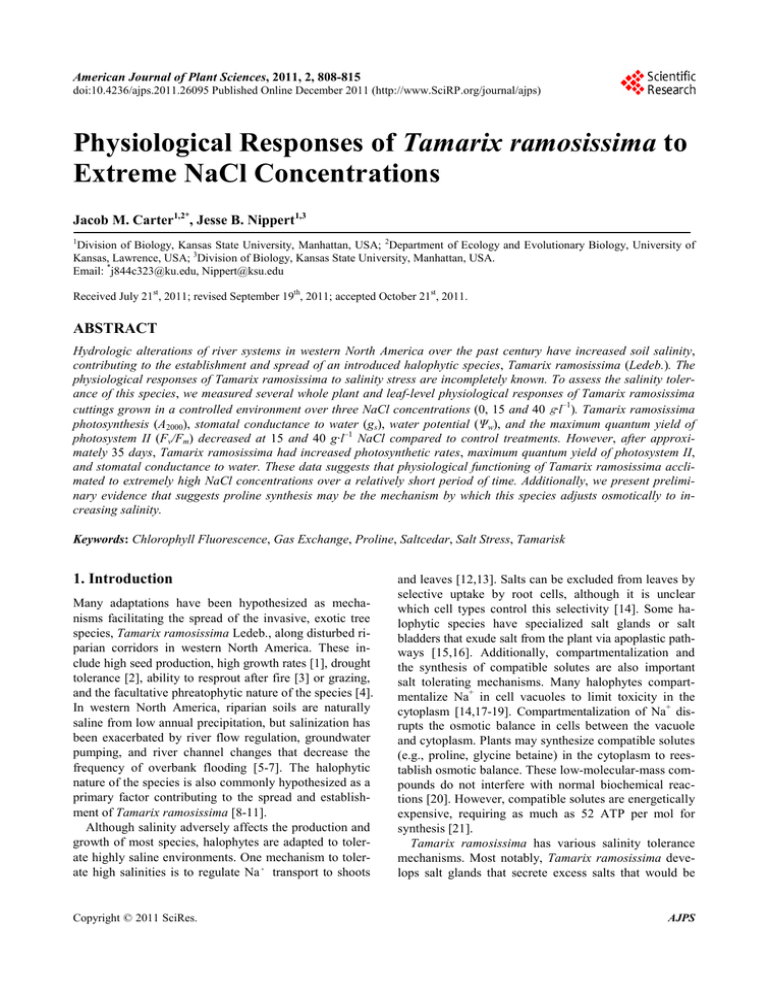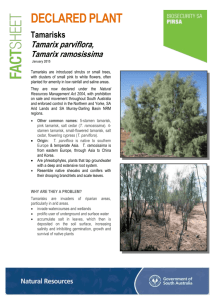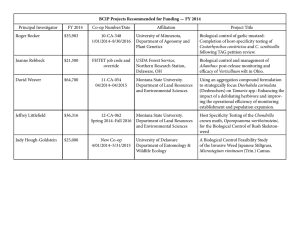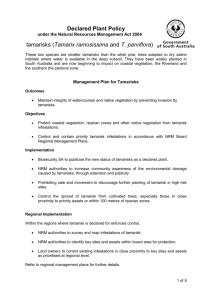Tamarix ramosissima Extreme NaCl Concentrations Jacob M. Carter , Jesse B. Nippert
advertisement

American Journal of Plant Sciences, 2011, 2, 808-815 doi:10.4236/ajps.2011.26095 Published Online December 2011 (http://www.SciRP.org/journal/ajps) Physiological Responses of Tamarix ramosissima to Extreme NaCl Concentrations Jacob M. Carter1,2*, Jesse B. Nippert1,3 1 Division of Biology, Kansas State University, Manhattan, USA; 2Department of Ecology and Evolutionary Biology, University of Kansas, Lawrence, USA; 3Division of Biology, Kansas State University, Manhattan, USA. Email: *j844c323@ku.edu, Nippert@ksu.edu Received July 21st, 2011; revised September 19th, 2011; accepted October 21st, 2011. ABSTRACT Hydrologic alterations of river systems in western North America over the past century have increased soil salinity, contributing to the establishment and spread of an introduced halophytic species, Tamarix ramosissima (Ledeb.). The physiological responses of Tamarix ramosissima to salinity stress are incompletely known. To assess the salinity tolerance of this species, we measured several whole plant and leaf-level physiological responses of Tamarix ramosissima cuttings grown in a controlled environment over three NaCl concentrations (0, 15 and 40 g·l–1). Tamarix ramosissima photosynthesis (A2000), stomatal conductance to water (gs), water potential (Ψw), and the maximum quantum yield of photosystem II (Fv/Fm) decreased at 15 and 40 g·l–1 NaCl compared to control treatments. However, after approximately 35 days, Tamarix ramosissima had increased photosynthetic rates, maximum quantum yield of photosystem II, and stomatal conductance to water. These data suggests that physiological functioning of Tamarix ramosissima acclimated to extremely high NaCl concentrations over a relatively short period of time. Additionally, we present preliminary evidence that suggests proline synthesis may be the mechanism by which this species adjusts osmotically to increasing salinity. Keywords: Chlorophyll Fluorescence, Gas Exchange, Proline, Saltcedar, Salt Stress, Tamarisk 1. Introduction Many adaptations have been hypothesized as mechanisms facilitating the spread of the invasive, exotic tree species, Tamarix ramosissima Ledeb., along disturbed riparian corridors in western North America. These include high seed production, high growth rates [1], drought tolerance [2], ability to resprout after fire [3] or grazing, and the facultative phreatophytic nature of the species [4]. In western North America, riparian soils are naturally saline from low annual precipitation, but salinization has been exacerbated by river flow regulation, groundwater pumping, and river channel changes that decrease the frequency of overbank flooding [5-7]. The halophytic nature of the species is also commonly hypothesized as a primary factor contributing to the spread and establishment of Tamarix ramosissima [8-11]. Although salinity adversely affects the production and growth of most species, halophytes are adapted to tolerate highly saline environments. One mechanism to tolerate high salinities is to regulate Na⁺ transport to shoots Copyright © 2011 SciRes. and leaves [12,13]. Salts can be excluded from leaves by selective uptake by root cells, although it is unclear which cell types control this selectivity [14]. Some halophytic species have specialized salt glands or salt bladders that exude salt from the plant via apoplastic pathways [15,16]. Additionally, compartmentalization and the synthesis of compatible solutes are also important salt tolerating mechanisms. Many halophytes compartmentalize Na+ in cell vacuoles to limit toxicity in the cytoplasm [14,17-19]. Compartmentalization of Na+ disrupts the osmotic balance in cells between the vacuole and cytoplasm. Plants may synthesize compatible solutes (e.g., proline, glycine betaine) in the cytoplasm to reestablish osmotic balance. These low-molecular-mass compounds do not interfere with normal biochemical reactions [20]. However, compatible solutes are energetically expensive, requiring as much as 52 ATP per mol for synthesis [21]. Tamarix ramosissima has various salinity tolerance mechanisms. Most notably, Tamarix ramosissima develops salt glands that secrete excess salts that would be AJPS Physiological Responses of Tamarix ramosissima to Extreme NaCl Concentrations accumulated by non salt-tolerant species [22]. Salt is excreted in solution through specialized salt glands via an apoplastic pathway to alleviate metabolic stress caused by Na+ [23]. Tamarix ramosissima also accumulates compatible solutes during periods of salinity stress. Studies conducted along the Tarim River, China [24,25] and the Yellow River, China [26] suggest Tamarix ramosissima accumulates compatible solutes (proline and soluble sugars) during salinity stress to maintain internal osmotic balance. Solomon et al. [27] also showed that Tamarix jordanis Boiss. synthesizes N-methyl-L-proline (MP) and N-methyl-trans-4-hydroxy-L-proline (MHP) in the presence of high NaCl content. Both solutes are effective at maintaining the carboxylating activity of Rubisco. Although Tamarix ramosissima has salt-tolerating mechanisms, physiological responses of Tamarix ramosissima to salinity stress are incompletely known and few studies have reported how increasing salinity impacts these responses. Kleinkopf and Wallace [11] reported increased salt concentrations had a marginal effect on the net exchange rates of carbon and water in Tamarix ramosissima. Kleinkopf and Wallace [11] also measured a decrease in Tamarix ramosissima growth as salinity increased, which they attributed to the increased energy required for pumping salts from leaf glands. Glenn et al. [8] grew a mix of shrubs and trees, including Tamarix ramosissima, in a greenhouse and subjected plants to a salinity gradient from 0 to 32 g·l–1 NaCl. Tamarix ramosissima transpiration decreased markedly between 16 and 32 g·l–1 NaCl, but growth rate showed only a minor reduction (2%). To address this gap in our understanding of the physiological responses of Tamarix ramosissima to soil salinity, we measured several whole plant and leaf-level physiological responses of cuttings grown at three NaCl concentrations in a controlled environment. Using these results, we address the effects of the NaCl concentrations tested (0, 15 and 40 g·l–1) in reducing gas exchange rates, leaf water potentials, and chlorophyll fluorescence. 2. Materials and Methods 2.1. Experimental Design and Procedures Branch tip cuttings of Tamarix ramosissima were collected from trees growing at two sites: the Ashland Research Site (ARS) adjacent to the Cimarron River near Ashland, Kansas, USA (37˚11'N and 99˚46'W) and the Cedar Bluff Reservoir (CBR) near Ellis, Kansas, USA (38˚48'N and 99˚43'W). Cuttings were kept moist, cut at the stem base (approximately 0.6 cm in diameter) and auxin was applied to promote root development. Cuttings were propagated in a Conviron (Pembina, North Dakota, Copyright © 2011 SciRes. 809 USA) growth chamber at Kansas State University (Manhattan, Kansas, USA) in plastic nursery pots (19.3 cm diameter, 17.8 cm deep). Prior to transplanting cuttings to pots, soils were soaked in a nutrient solution made up of 20% nitrogen 20% phosphoric acid, 20% soluble potash, 0.02% boron, 0.05% chelated copper, 0.15% chelated iron, 0.05% chelated manganese, 0.0009% molybdenum, and 0.05% chelated zinc. Pots contained 550 g of a mixture of potting soil and native soil (1:1 v/v). Native soils were collected from both the Ashland research site and Cedar Bluffs Reservoir. Controlled environment conditions were set on a 12-hour photoperiod. NaCl was added to distilled water to make solutions of 0, 15, and 40 g·l–1 NaCl. Salinity trials were initiated by irrigating pots with 400 ml of NaCl solution over a four day period (100 ml per day) to reduce salinity shock on the cuttings. Physiological responses were measured biweekly on each cutting, after the total solution was added. Measurements continued until all plants within the 40 g·l–1 treatment were dead, which varied between 65 - 75 days. A total of 48 cuttings were used in the experiment. The control treatment contained 12 cuttings, whereas the 15 and 40 g·l–1 treatments contained 18 cuttings each. Tamarix ramosissima cuttings collected from both sites were assigned to treatments at random. 2.2. Plant Physiology Gas exchange measurements were taken using a Licor6400 infra-red gas analyzer with a red/blue light source and a CO2 injector (Licor Inc., Lincoln, Nebraska, USA). Irradiance inside the cuvette was 2000 µmol·m–2·s–1, CO2 concentration was 400 ppm and the relative humidity was maintained at ambient. Measurements reported include photosynthetic rate at 2000 µmol·m–2·s–1 (A2000), stomatal conductance to water vapor (gs), and intercellular CO2 concentration (Ci). Projected leaf area within the gas exchange cuvette was estimated using a Licor 3100 leaf area meter. Water potentials were measured using a Scholander pressure bomb (PMS Instruments, Albany, Oregon, USA) and the maximum quantum yield of photosystem II (Fv/Fm) was measured using a chlorophyll fluorometer (Walz Instruments, Germany). The last biweekly measurements before death were analyzed for each cutting using a mixed-effects model ANOVA in SAS 9.1. (Cary, North Carolina, USA). NaCl concentration was treated as a fixed effect in the model whereas date of sampling was considered a random effect to account for repeated measures in the experimental design. 2.3. Stable Isotope Analysis On each sampling date, approximately 1g of leaf sample was collected from each cutting. Each sample was dried for 48 hours at 60˚C. Samples were ground with liquid AJPS 810 Physiological Responses of Tamarix ramosissima to Extreme NaCl Concentrations nitrogen and then analyzed for their stable carbon isotopic signature (δ13C) using a Finnigan Delta-plus continuous flow isotope ratio mass spectrometer connected to an elemental analyzer. Within run precision was <0.04‰ for δ13C, while between run variation was <0.12‰ for δ13C. 2.4. Proline Determination Free proline was determined spectrophotometrically following methods from Bates et al. [28]. A standard curve was generated using L-Proline. Approximately 0.5 g of plant material was homogenized in 10 ml of 3% sulfosalicylic acid. The homogenate was filtered through Whatman #2 filter paper and then reacted with 2 ml acid-ninhydrin and 2 ml of glacial acetic acid for 1 hour at 100˚C in a test tube. The reaction was stopped by placing test tubes in an ice water bath and then mixing vigorously with toluene. The chromophore containing toluene was separated and absorbance read at 520 nm using toluene as a blank. To react at least 0.5 g of plant material with 3% sulfosalicylic acid required us to use all leaf tissues from all samples per salinity treatment by sampling date. 3. Results Leaf-level gas exchange measurements suggest Tamarix ramosissima physiological functioning varied as a function of salinity (Figure 1). Photosynthetic rates ranged from 0.2 to 37 µmol CO2 m–2·s–1 among all treatments. Photosynthesis declined by 50% between control and the 40 g·l–1 NaCl treatment, but did not vary significantly by salinity treatment (p = 0.30, Figure 1(a)). Stomatal conductance to water vapor ranged from 0.01 to 0.48 mol H2O m–2·s–1 among treatments. Stomatal conductance values significantly declined nearly 75% from 0 g·l–1 NaCl concentration to 40 g·l–1 NaCl concentration (p < 0.05; Figure 1(b)). Leaf-level stomatal conductance and photosynthetic rates were lower at the 15 g·l–1 NaCl concentration compared to the control, but did not vary significantly (Figures 1(a), (b)). Decreases in the maximum quantum yield of photosystem II (Fv/Fm) suggest Tamarix ramosissima metabolic functioning significantly declined as salinity increased from 15 to 40 g·l–1 NaCl (p < 0.05; Figure 1(c)). Mean maximum quantum yield of photosystem II for the 40 g·l–1 treatment was 0.76 ± 0.015, whereas mean maximum quantum yield of photosystem II for control plants was 0.81 ± 0.007. The maximum quantum yield of photosystem II ranged from 0.59 to 0.84. Ψw varied significantly as salinity increased (p < 0.001; Figure 1(d)). Ψw ranged from –0.3 to –4.0 among treatments. Mean Ψw values were nearly two times lower in 40 g·l–1 NaCl treatments compared to controls. Neither above-ground nor below-ground biomass were significantly affected by Copyright © 2011 SciRes. salinity concentrations tested (p > 0.05; Figures 1(e), (f)). Leaf δ13C significantly varied as salinity increased (p < 0.05; Figure 1(g)). Leaf δ13C was most enriched in 40 g·l–1 NaCl concentration and the most depleted in control treatments. δ13C values ranged from –28.1 to –36.9 among treatments. Tamarix ramosissima physiological functioning acclimated to salinity over time (Figure 2). Photosynthetic rates declined immediately after initial NaCl additions, but began to increase after approximately 35 days (Figure 2(a)). However, of the 3 treatments, Tamarix ramosissima cuttings in the 40 g·l–1 NaCl treatment consistently exhibited lower photosynthesis, stomatal conductance to water, maximum quantum yield of photosystem II, and the highest proline concentrations compared to the 0 and 15 g·l–1 NaCl treatments (Figure 2). All plants subjected to the 40 g·l–1 NaCl concentration treatment died between 60 - 75 days after induction of the treatment. 4. Discussion The salt tolerance of Tamarix ramosissima is likely one mechanism by which this species persists and expands its range in western North America compared to native riparian species [29-32]. Increasing salinity is known to cause physiological stress in most species [19,33,34], but few studies have examined the physiological responses of Tamarix ramosissima to salinity [8,11]. Our results are consistent with Glenn et al. [8], suggesting that Tamarix ramosissima leaf-level physiological responses decrease at extremely high NaCl concentrations. Our results also show short term acclimation to both high salinity treatments, however, growth in extreme salt concentrations (40 g·l–1) eventually resulted in death regardless of an acclimation response. Previous work has shown that salinity imparts both ionic and osmotic stress [18,19]; our results suggest Tamarix ramosissima was impacted by both at high Salinity. Osmotic stress had the greatest impact on Tamarix ramosissima individuals. High NaCl concentration reduced stomatal conductance and Ψw (Figures 1(b), (d)). Ψw is highly sensitive to saline soils such that reduced water availability can be a dominant factor determining plant responses to stress [35,36]. Even low-level salt exposure can impact plant-water relations [37,38]. It is difficult to partition alterations in physiological functioning to water stress or salt-specific effects, as these changes can be co-dependent over time. After minutes to hours, growth rates and physiological responses instantaneously decline as salinity concentrations increase. Typically there is a partial recovery after initial declines, but growth rates and physiological functioning still remain low when under salt stress [14,18,19]. These quick declines also occur in plants where KCl, mannitol, or polyethylene AJPS Physiological Responses of Tamarix ramosissima to Extreme NaCl Concentrations – 811 – Figure 1. Tamarix ramosissima mean (±1 SE) (a) photosynthetic rate at 2000 µmol m 2·s 1 (Aat 2000), (b) stomatal conductance to water vapor (gs), (c) the maximum quantum yield of photosystem II (Fv/Fm), (d) water potential (Ψw), (e) above-ground and (f) below-ground biomass, and (g) δ13C among three NaCl concentrations. Copyright © 2011 SciRes. AJPS 812 Physiological Responses of Tamarix ramosissima to Extreme NaCl Concentrations Figure 2. Tamarix ramosissima (a) photosynthetic rate at 2000 µmol m–2·s–1 (Aat2000), (b) maximum quantum yield of photosystem II (Fv/Fm), (c) stomatal conductance to water vapor (gs), and (d) proline concentration over time across three NaCl concentrations (closed circles = 0 g·l–1 [NaCl], opened circles = 15 g·l–1 [NaCl], closed triangles = 40 g·l–1 [NaCl]). glycol (PEG) have been added, suggesting these responses are not solely salt-specific [20,39]. In the present study, Tamarix ramosissima plants subjected to 40 g·l–1 NaCl showed marked physiological declines after 14 days (Figure 2). Declines in the maximum quantum yield of photosystem II, photosynthesis, and stomatal conductance were consistent after 28 days. However, these parameters increased after 40 days. Corresponding to these increases, free proline concentration also increased in all treatments after 28 days. An increase in free proline concentration is an indicator of water stress [28,40,41]. It is possible that Tamarix ramosissima was able to maintain physiological functioning, including water status, by accumulating proline. Similar results have been shown for Tamarix jordanis [27]. It is also important to note that our high salinity treatment (40 g·l–1 or 40,000 ppm NaCl) constitutes an extreme salinity endpoint. Tamarix ramosissima was able to acclimate to this extreme salinity over ~35 days. The highest documented soil salinity reported for Tamarix ramosissima in the US Copyright © 2011 SciRes. is approximately 20,000 ppm in the delta of the Colorado River where the species gives way to obligate halophytes such as Distichlis palmeri (Vasey) Fassett ex I.M. Johnst. [42]. The ability to acclimate to extreme salinities could provide a competitive advantage for Tamarix ramosissima over native glycophytes. Proline accumulation is not the only tolerance strategy that halophytic species may utilize to maintain osmotic balance. Guard cells may be triggered to close around stomatal pores to conserve water when under osmotic stress [43,44]. The integrated stomatal behavior of leaves is commonly inferred by measuring the δ13C stable isotopic signature as an estimate of water use efficiency [45]. Our results suggest high salinity reduces stomatal aperture in Tamarix ramosissima. Values of leaf δ13C were, on average, heaviest in 40 g·l–1 treatments suggesting greatest stomatal regulation compared to 0 and 15 g·l–1 NaCl treatments. Similarly, our gas exchange data show reduced stomatal conductance at 40 g·l–1 NaCl. In controlled outdoor experiments Tamarix ramosissima AJPS Physiological Responses of Tamarix ramosissima to Extreme NaCl Concentrations 813 maintains high leaf stomatal conductance when under water or salt stress [9,46-48]. The overall objective of this study was to assess whole plant and leaf-level physiological responses of Tamarix ramosissima to extreme NaCl concentrations. Previous results suggested that Tamarix ramosissima maintained physiological functioning in the field from 0 to 14 g·l–1 NaCl [47]. In this study, Tamarix ramosissima had decreased gas exchange, maximum quantum yield of photosystem II, and Ψw at 15 and 40 g·l–1 NaCl, compared to the control. Physiological functioning changed over time as salinity stress was induced, suggesting short-term acclimation. Results from this study suggest that NaCl concentrations of 15 g·l–1 or higher impact Tamarix ramosissima physiological functioning, but physiological responses may acclimate over time, even at extremely high salinities. Long-term physiological acclimation to high salinities by this species will require further assessment. [6] D. M. Merritt and N. L Poff, “Shifting Dominance of Riparian Populus and Tamarix along Gradients of Flow Alteration in Western North American Rivers,” Ecological Applications, Vol. 20, No. 1, 2010, pp. 135-152. doi:10.1890/08-2251.1 [7] J. C. Stromberg, S. J. Lite, R. Marler, C. Paradzick, P. B. Shafroth, D. Shorrock, et al., “Altered Stream-Flow Regimes and Invasive Plant Species: The Tamarix Case,” Global Ecology and Biogeography, Vol. 16, No. 3, 2007, pp. 381-393. doi:10.1111/j.1466-8238.2007.00297.x [8] E. Glenn, R. Tanner, S. Mendez, T. Kehret, D. Moore, J. Garcia and C. Valdes, “Growth Rates, Salt Tolerance and Water Use Characteristics of Native and Invasive Riparian Plants from the Delta of the Colorado River Delta, Mexico,” Journal of Arid Environments, Vol. 40, No. 3, 1998, pp. 281-294. doi:10.1006/jare.1998.0443 [9] E. Glenn and P. Nagler, “Comparative Ecophysiology of Tamarix ramosissima and Native Trees in Western U.S. Riparian Zones,” Journal of Arid Environments, Vol. 61, No. 3, 2005, pp. 419-446. doi:10.1016/j.jaridenv.2004.09.025 5. Acknowledgements [10] W. E. Hayes, L. R. Walker and E. A. Powell, “Competitive Abilities of Tamarix aphylla in Southern Nevada,” Plant Ecology, Vol. 202, No. 1, 2009, pp. 159-167. doi:10.1007/s11258-008-9569-9 We would like to thank the anonymous reviewers whose comments improved this manuscript. We would also like to thank Dave Arnold and Cedar Bluffs State Park for allowing us to collect cuttings from their land. We also thank the following people who contributed to this work: John Blair, Brian Maricle, Jeff Hartman, Sally Tucker, Gracie Orozco, Teall Culbertson, and Kristen Polacik. We acknowledge support from NSF DGE-0841414 and the Kansas State University GK-12 program, the Division of Biology at Kansas State University, and the Konza Prairie Long-Term Ecological Research program. REFERENCES [1] P. Friederici, “The Alien Saltcedar,” American Forests, Vol. 101, No. 1-2, 1995, pp. 45-47. [2] J. Cleverly, S. Smith, A. Sala and D. Devitt, “Invasive Capacity of Tamarix ramosissima in a Mojave Desert Floodplain: The Role of Drought,” Oecologia, Vol. 108, 1997, pp. 583-595. [11] G. E. Kleinkopf and A. Wallace, “Physiological Basis for Salt Tolerance in Tamarix ramosissima,” Plant Science Letters, Vol. 3, No. 3, 1974, pp. 157-163. doi:10.1016/0304-4211(74)90071-6 [12] A. Amtmann and D. Sanders, “Mechanisms of Na⁺ Uptake by Plant Cells,” Advances in Botanical Research, Vol. 29, 1999, pp. 75-112. doi:10.1016/S0065-2296(08)60310-9 [13] T.A. Cuin, A. Miller, S. Laurie and R. Leigh, “Potassium Activities in Cell Compartments of Salt-Grown Barley Leaves,” Journal of Experimental Botany, Vol. 54, No. 383, 2003, pp. 657-661. doi:10.1093/jxb/erg072 [14] R. Munns, “Comparative Physiology of Salt and Water Stress,” Plant, Cell and Environment, Vol. 25, 2002, pp. 239-250. doi:10.1046/j.0016-8025.2001.00808.x [3] D. Busch and S. Smith, “Effects of Fire on Water and Salinity Relations of Riparian Woody Taxa,” Oecologia, Vol. 94, No. 2, 1993, pp. 186-194. doi:10.1007/BF00341316 [15] S. Agarie , T. Shimoda, Y. Shimizu, K. Baumann, H. Sunagawa, A. Kondo, et al., “Salt Tolerance, Salt Accumulation, and Ionic Homeostasis in an Epidermal Bladder- Cell-Less Mutant of the Common Ice Plant Mesembryanthemum crystallinum,” Journal of Experimental Botany, Vol. 58, No. 8, 2007, pp. 1957-1967. doi:10.1093/jxb/erm057 [4] J. B. Nippert, J. J. Butler, G. J. Kluitenberg, D. O. Whittemore, D. Arnold, S. E. Spal and J. K. Ward, “Patterns of Tamarix Water Use during a Record Drought,” Oecologia, Vol. 162, No. 2, 2010, pp. 283-292. doi:10.1007/s00442-009-1455-1 [16] J. Park, T. Okita and G. Edwards, “Salt Tolerant Mechanisms in Single-Cell C-4 species Bienertia sinuspersici and Suaeda aralocaspica (Chenopodiaceae),” Plant Science, Vol. 176, No. 5, 2009, pp. 616-626. doi:10.1016/j.plantsci.2009.01.014 [5] V. B. Beauchamp, C. Walz and P. B. Shafroth, “Salinity Tolerance and Mycorrhizal Responsiveness of Native Xero- riparian Plants in Semi-Arid western USA,” Applied Soil Ecology, Vol. 43, 2009, pp. 175-184. doi:10.1016/j.apsoil.2009.07.004 [17] S. Mahajan and N. Tuteja, “Cold, Salinity and Drought Stresses: An Overview,” Archives of Biochemistry and Biophysics, Vol. 444, No. 2, 2005, pp. 139-158. doi:10.1016/j.abb.2005.10.018 Copyright © 2011 SciRes. [18] A. K. Parida and A. Das, “Salt Tolerance and Salinity AJPS 814 Physiological Responses of Tamarix ramosissima to Extreme NaCl Concentrations Effects on Plants: A Review,” Ecotoxicology and Environmental Safety, Vol. 60, No. 3, 2005, pp. 324-349. doi:10.1016/j.ecoenv.2004.06.010 [19] M. Tester and R. Davenport, “Na⁺ Tolerance and Na⁺ Transport in Higher Plants,” Annals of Botany, Vol. 91, 2003, pp. 503-527. doi:10.1093/aob/mcg058 [20] G. Zhifang and W. H. Loescher, “Expression of a Celery Mannose-6-phosphate Reductase in Arabidopsis thaliana Enhances Salt Tolerance and Induces Biosynthesis of Both Mannitol and a Glucosyl-Mannitol Dimer,” Plant Cell and Environment, Vol. 26, No. 2, 2003, pp. 275-283. doi:10.1046/j.1365-3040.2003.00958.x [21] J. A. Raven, “Regulation of pH and Generation of Osmolarity in Vascular Plants: A Cost-Benefit Analysis in Relation to Efficiency of Use of Energy, Nitrogen and Water,” New Phytologist, Vol. 101, No. 1, 1985, pp. 25-77. doi:10.1111/j.1469-8137.1985.tb02816.x [22] R. Wilkinson, “Seasonal Development of Anatomical Structures of Saltcedar Foliage,” Botanical Gazette, Vol. 127, No. 4, 1966, pp. 231-234. doi:10.1086/336369 [23] W. Berry, “Characterisitics of Salts Secreted by Tamarix aphylla,” American Journal of Botany, Vol. 57, No. 10, 1970, pp. 1226-1230. doi:10.2307/2441362 [24] X. Ruan, Q. Wang, Y. Chen and W. Li, “Physiological Response of Riparian Plants to Watering in Hyper-Arid Areas of Tarim River, China,” Frontiers of Biology in China, Vol. 2, No. 1, 2007, pp. 54-61. doi:10.1007/s11515-007-0010-x [25] X. Ruan, Q. Wang, C. Pan, Y. Chen and H. Jian, “Physiological Acclimation Strategies of Riparian Plants to Environment Change in the Delta of the Tarim River, China,” Environmental Geology, Vol. 57, No. 8, 2009, pp. 17611773. doi:10.1007/s00254-008-1461-3 [26] B. Cui, Q. Yang, K. Zhang, X. Zhao and Z. You, “Responses of Saltcedar (Tamarix chinensis) to Water Table Depth and Soil Salinity in the Yellow River Delta, China,” Plant Ecology, Vol. 209, No. 2, 2010, pp. 279290. doi:10.1007/s11258-010-9723-z [27] A. Solomon, S. Beer, Y. Waisel, G. P. Jones and L. G. Paleg, “Effects of NaCl on the Carboxylating Activity of Rubisco from Tamarix jordanis in the Presence and Absence of Proline-Related Compatible Solutes,” Physiologia Plantarum, Vol. 90, No. 1, 1994, pp. 198-204. doi:10.1111/j.1399-3054.1994.tb02211.x [28] L. S. Bates, R. P. Waldren and I. D. Teare, “Rapid Determination of Free Proline for Water-Stress Studies,” Plant and Soil, Vol. 39, No. 1, 1972, pp. 205-207. doi:10.1007/BF00018060 [29] S. K. Arndt, C. Arampatsis, A. Foetzki, X. Li, F. Zeng and X. Zhang, “Contrasting Patterns of Leaf Solute Accumulation and Salt Adaptation in Four Phreatophytic Desert Plants in a Hyperarid Desert with Saline Groundwater,” Journal of Arid Environments, Vol. 59, No. 2, 2004, pp. 259-270. doi:10.1016/j.jaridenv.2004.01.017 [30] C. G. Ladenburger, A. L. Hild, D. J. Kazmer and L. C. Munn, “Soil Salinity in Tamarix Invasions in the Bighorn Basin, Wyoming, USA,” Journal of Arid Environments, Copyright © 2011 SciRes. Vol. 65, No. 1, 2006, pp. 111-128. doi:10.1016/j.jaridenv.2005.07.004 [31] P. B. Shafroth, J. M. Friedman and L. S. Ischinger, “Effects of Salinity on Establishment of Populus fremontii (cottonwood) and Tamarix ramosissima (Saltcedar) in Southwestern United States,” Great Basin Naturalist, Vol. 55, No. 1, 1995, pp. 58-65. [32] M. W. Vandersande, E. P. Glenn and J. L. Walworth, “Tolerance of Five Riparian Plants from the Lower Colorado River to Salinity Drought and Inundation,” Journal of Arid Environments, Vol. 49, No. 1, 2001, pp. 147-159. doi:10.1006/jare.2001.0839 [33] M. A. Khan, I. A. Ungar and A. M. Showalter, “Effects of Sodium Chloride Treatments on Growth and Ion Accumulation of the Halophyte Haloxylon recurvum,” Communications in Soil Science and Plant Analysis, Vol. 31, No. 17-18, 2000, pp. 2763-2774. doi:10.1080/00103620009370625 [34] L. Leport, J. Baudry, A. Radureau and A. Bouchereau, “Sodium, Potassium and Nitrogenous Osmolyte Accumulation in Relation to the Adaptation to Salinity of Elytrigia pycnantha, an Invasive Plant of the Mont SaintMichel Bay,” Les Cashiers de Biologie Marine, Vol. 47, No. 1, 2006, pp. 31-37. [35] Y. Huang, Z. Bie, Z. Liu, A. Zhen and W. Wang, “Protective Role of Proline against Salt Stress is Partially Related to the Improvement of Water Status and Peroxidase Enzyme Activity in Cucumber,” Soil Science and Plant Nutrition, Vol. 55, No. 5, 2009, pp. 698-704. doi:10.1111/j.1747-0765.2009.00412.x [36] A. R. Yeo, S. M. Capron and T. J. Flowers, “The Effect of Salinity upon Photosynthesis in Rice (Oryza sativa L.): Gas Exchange by Individual Leaves Relation to Their Salt Content,” Journal of Experimental Botany, Vol. 36, No. 8, 1985, pp. 1240-1248. doi:10.1093/jxb/36.8.1240 [37] B. W. Touchette, K. L. Rhodes, G. A. Smith and M. Poole, “Salt Spray Induces Osmotic Adjustment and Tissue Rigidity in Smooth Cordgrass, Spartina alterniflora (Loisel.),” Estuaries and Coasts, Vol. 32, No. 5, 2009, pp. 917-925. doi:10.1007/s12237-009-9178-4 [38] B. W. Touchette, G. A. Smith, K. L. Rhodes and M. Poole, “Tolerance and Avoidance: Two Contrasting Physiological Responses to Salt Stress in Mature Marsh Halophyte Juncus roemerianus Scheele and Spartina alterniflora Loisel.,” Journal of Experimental Marine Biology and Ecology, Vol. 380, No. 1-2, 2009, pp. 106-112. doi:10.1016/j.jembe.2009.08.015 [39] I. Slama, T. Ghnaya, K. Hessini, D. Messedi, A. Savouré and C. Abdelly, “Comparative Study of the Effects of Mannitol and PEG Osmotic Stress on Growth and Solute Accumulation in Sesuvium portulacastrum,” Environmental and Experimental Botany, Vol. 61, No. 1, 2007, pp. 10-17. doi:10.1016/j.envexpbot.2007.02.004 [40] S. Bhaskaran, R. H. Smith and R. J. Newton, “Physiological Changes in Cultured Sorghum Cells in Response to Induced Water Stress. I. Free Proline,” Plant Physiology, Vol. 79, No. 1, 1985, pp. 266-269. doi:10.1104/pp.79.1.266 AJPS Physiological Responses of Tamarix ramosissima to Extreme NaCl Concentrations [41] T. N. Singh, D. Aspinall and L. G. Paleg, “Proline Accumulation and Varietal Adaptability to Drought in Barley: A Potential Metabolic Measure of Drought Resistance,” Nature-New Biology, Vol. 236, No. 67, 1972, pp. 188-190. [42] E. Glenn, R. Lee, C. Felger and S. Zengel, “Effects of Water Management on the Wetlands of the Colorado River Delta, Mexico,” Journal of Arid Environments, Vol. 10, No. 4, 1996, pp. 281-294. [43] J. S. Boyer, “Effects of Osmotic Water Stress on Metabolic Rates of Cotton Plants with Open Stomata,” Plant Physiology, Vol. 40, No. 2, 1965, pp. 229-234. doi:10.1104/pp.40.2.229 [44] M. R. Kaufmann, “Evaluations of Season, Temperature, and Water Stress Effects on Stomata Using a Leaf Conductance Model,” Plant Physiology, Vol. 69, No. 5, 1982, pp. 1023-1026. doi:10.1104/pp.69.5.1023 815 Templer and K. P. Tu, “Stable Isotopes in Plant Ecology,” Annual Review of Ecology, Evolution, and Systematics, Vol. 33, No. 1, 2002, pp. 507-559. doi:10.1146/annurev.ecolsys.33.020602.095451 [46] D. Busch and S. Smith, “Mechanisms Associated with The Decline of Woody Species in Riparian Ecosystems of the Southwestern U.S.,” Ecological Monographs, Vol. 65, 1995, pp. 347-370. doi:10.2307/2937064 [47] J. M. Carter and J. B. Nippert, “Leaf-Level Physiological Response of Tamarix ramosissima to Increasing Salinity,” Journal of Arid Environments, in press. [48] P. Nagler, E. Glenn and T. L. Thompson, “Comparison of Transpiration of Cottonwood, Willow and Saltcedar Trees Measured by Sap Flow and Canopy Temperature Methods,” Agricultural and Forest Metereology, Vol. 116, No. 1-2, 2003, pp. 73-89. doi:10.1016/S0168-1923(02)00251-4 [45] T. E. Dawson, S. Mambelli, A. H. Plamboeck, P. H. Copyright © 2011 SciRes. AJPS





